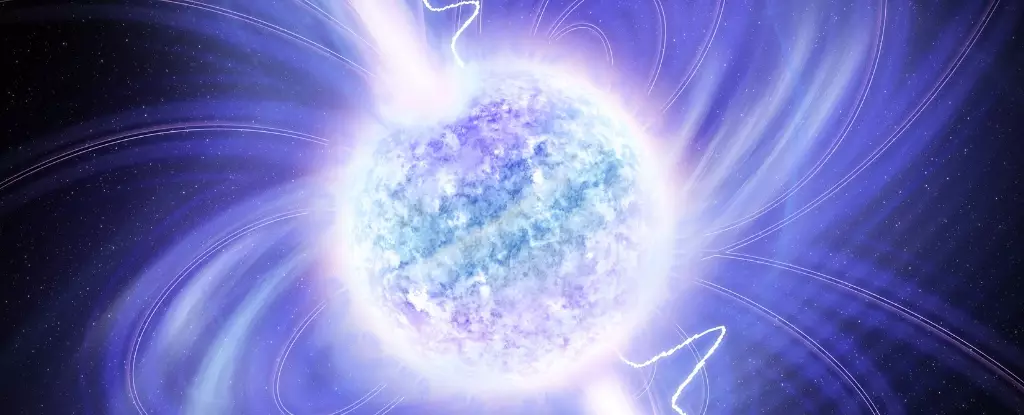In the realm of astrophysics, pulsars have captured the imagination of scientists and amateurs alike. These extraordinary celestial bodies, notable for their rapid spin and periodic emission of radio waves, resemble cosmic lighthouses. They are neutron stars that emit periodic radio pulses as they rotate, much like a lighthouse beam sweeps across the horizon. Pulsars typically complete a rotation in mere seconds or even less, making them ideal candidates for clocking temperatures of immense gravitational forces and extreme densities.
However, the astronomy community has recently been privy to unexpected celestial phenomena. Over the past several years, objects exhibiting slower, periodic radio emissions have emerged, challenging current astrophysical frameworks. The recent detection of ASKAP J1839-0756 presents an unprecedented case: a pulsar that spins once every 6.5 hours, establishing a new paradigm for our understanding of these cosmic phenomena.
The Discovery of ASKAP J1839-0756
The discovery was made using CSIRO’s ASKAP radio telescope, situated in Western Australia’s Wajarri Yamaji country. During routine observations, the unusual radio signals from ASKAP J1839-0756 drew attention due to the absence of any previously cataloged objects in the region. Spectacularly, the signals demonstrated a dramatic drop in brightness, decreasing by as much as 95% within just 15 minutes. Initial observations were misleading; only a lone burst was detected, leaving researchers puzzled.
To untangle the enigma, a series of sophisticated observations were carried out using multiple facilities, including the Australia Telescope Compact Array and the MeerKAT radio telescope in South Africa. After an extended observation period, two distinct pulses separated by 6.5 hours were finally identified, confirming the object’s periodic nature and sealing its reputation as the slowest known pulsar.
According to prevailing astrophysical theory, neutron stars, including pulsars, are expected to slow down and lose their capacity to emit radio waves as their rotation slows below a particular threshold – usually around one rotation per minute. Given these guidelines, ASKAP J1839-0756 seemingly defies the limits imposed by current science. The very existence of this slow cosmic generator challenges foundational principles regarding neutron stars.
Typically, the radio emissions from pulsars are compared to one-sided flashlights—where the axis of rotation aligns with the magnetic field axis give rise to light observable from a single pole. However, ASKAP J1839-0756 reveals an intriguing double signature in its emissions. By positioning itself well relative to Earth, this object allows us to observe light from both its magnetic poles, a unique occurrence among pulsars.
The Revealing Interpulse Phenomenon
A remarkable feature of ASKAP J1839-0756 is the presence of interpulses—weak emissions detected approximately 3.2 hours after the main pulse. This duality strongly indicates that we are observing signals from both magnetic poles, providing invaluable insights into the celestial mechanics at play. Such insights prompt necessary questions about how alignment between a pulsar’s rotational and magnetic axes might shift as the star’s rotation decelerates.
Notably, the implications of these findings reach far beyond merely understanding ASKAP J1839-0756. They pose profound questions about similar singularities in the cosmos and potentially open doors to new theories concerning neutron star behavior.
Exploring Potential Explanations
This leads us into speculation regarding the nature of ASKAP J1839-0756. One plausible explanation is that this object might be a magnetar, an exotic variant of neutron stars possessing incredibly strong magnetic fields. Magnetars can emit pulses in unconventional manners, potentially enabling them to maintain radio emissions even at lethargic rotation rates. Meanwhile, current literature often depicts magnetars as spinning much faster—frequently measured in seconds—creating further uncertainty.
Alternatively, astronomers have hypothesized the possibility of white dwarfs, which are the remnants of less massive stars. While known for slower rotation, the lack of observed isolated, radio-emitting white dwarfs complicates this theory. Observations across various wavelengths have not unveiled any conclusive evidence of white dwarf activity at the coordinates of ASKAP J1839-0756.
Regardless of what ASKAP J1839-0756 ultimately turns out to be, its existence heralds significant consequences for the field of astrophysics. The anomalous features of this cosmic lighthouse prompt researchers to reconsider the established limits and behaviors of neutron stars. The universe, it seems, has again reminded us of its propensity for surprises, especially when we believe we have unraveled its mysteries.
As astronomers continue to scrutinize ASKAP J1839-0756, there exists immense potential for revelation, deepening our understanding of the cosmos and its myriad phenomena. The discovery underlines a crucial element of scientific inquiry: the importance of challenging conventional wisdom and remaining open to the infinite possibilities that lie beyond the known realm.


Leave a Reply